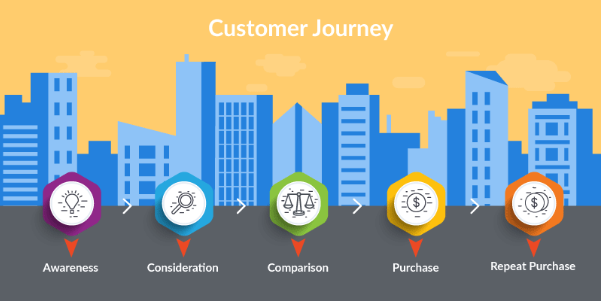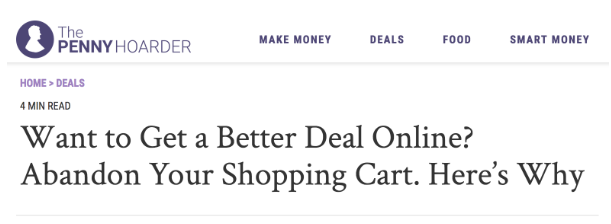Australians love to shop online. Especially around Christmas. There was a recorded 34 million domestic parcel deliveries for Christmas in 2017, and another 5.6 million coming from overseas. Consumers are getting good at online shopping, and they’re getting more savvy and more discerning with each sale.
If you’re an online retailer, you definitely would be seeing this in your abandoned cart rates. A whopping 67% of online shopping carts are abandoned before a purchase can be made, with abandoned carts representing between 2 to 4 trillion dollars in unearned revenue per year. For a bunch of consumers who love shopping so much, they sure do a lot of not shopping.
Why do shoppers abandon their carts?
This is a question almost every online retailer would have asked themselves at some point or another. And it’s a very important question, with no single definitive answer. There are just so many reasons why shoppers abandon their carts:
- Some consumers don’t like being forced to create an account
- Your shop’s checkout method might be a bit too complicated
- Unexpected fees could bring the total cost too high
- A shopper might have concerns over security.
These are just some of the reasons commonly cited when you’re looking for strategies to reduce the number of abandoned carts. But very few actually mention anything to do with the shopping cart itself, at all. You’ll find a lot of tips on how to tighten up the ‘Purchase’ process as a way of reducing abandoned carts.
But what if the issue isn’t actually with the ‘Purchase’ process? What if shopping carts aren’t even a part of the ‘Purchase’ process in the first place?
Where does the shopping cart fit in the Customer Journey?
Consumer behavior online is always changing, with online businesses often playing catch up. In the mind of a lot of online retailers, the online shopping cart comes into play during the ‘Purchase’ stage of the customer journey.

This thought process makes a lot of sense. Once a shopper recognizes the need for something, has conducted a bit of research, checked out reviews, compared prices, and decided to purchase from you, they visit your store, and add the items they want to their cart on their way through to check out.
It’s a journey that closely models physically shopping in-store. And just like in a physical store, adding an item to a shopping cart seemingly indicates high intent and readiness to purchase.
But therein lies a fundamental flaw in this reasoning. Of course, everybody knows online shopping is vastly different to in-store shopping, but few of us take that fact all the way down to the nuts and bolts of it. The very shopping cart itself is vastly different. And not fully appreciating this fact could see you leaving a lot of money on the table.
Consumers aren’t using the shopping cart to purchase.
It’s becoming more and more frequent that consumers are using online shopping carts, not to facilitate their purchase, but instead to conduct their research. So in reality, for a lot of consumers, the ‘add to cart’ action actually occurs much earlier in the Customer Journey, somewhere between the ‘Consideration’ and ‘Comparison’ stage, and not the ‘Purchase’ stage. But what’s causing this shift?
Specials just aren’t that special anymore.
Consumers are trained to seek out deals and have become conditioned to expect discounts. Retailers and online stores alike release deals and discounts so frequently, that regular consumers don’t expect to pay full price for just about anything anymore.
Tune in to lifestyle TV shows, or even the nightly news, especially in the lead up to Christmas, and you’re sure to come across pieces dedicated entirely to finding deals. Blogs and communities centered around finding deals and sharing tips on getting more value for money are becoming increasingly popular.
And one common tactic you’ll find repeated in these circles is deliberately abandoning online shopping carts.

(source: thepennyhoarder.com)

(source: forbes.com)

(source: daveramsey.com)
Consumers are getting more and more savvy with each passing sale. They’re learning that an abandoned cart will most likely result in an offer waiting in their inbox. And an offer, be it a simple discount, free express shipping, or an extra gift, can directly affect the perceived cost and/or the perceived benefit of the potential purchase.
And this determination of the cost and the benefit of a potential purchase is a core step in the Consideration phase and provides the basis for the Comparison stage of the customer journey.
So how do you capitalize on this new role that the shopping cart has taken on?
To put it simply, give these shoppers what they’re looking for. We know an abandoned cart could be a potential buyer conducting research. They’re trying to determine your product’s value (perceived benefit – perceived cost = perceived value), so they can compare you against competitors.
So why not help them conduct their research?
Make your value clear. Increase the perceived benefit, and/or decrease the perceived cost of purchasing from you. Send your potential customer an offer, they’re expecting it. If you don’t, and your competitor does, the purchase will most likely go to them.
Follow up with an abandoned cart email
If you’re not already using abandoned cart emails, you could be leaving a lot of money on the table. Abandoned cart emails are often the simplest and arguably the most effective way to bring potential customers back to you. In fact, studies have shown 58% of shoppers who abandoned their cart indicate that emails and ads offering discounts on the abandoned products bring them back to the website.
Abandoned cart emails have also been found to have an average open rate of 44.1%, with a click rate of 11.61%. And of those clicks, an average of one-third result in a purchase back on site. What’s better still, is the average order value from abandoned cart emails can be as much as 14.2% higher than the typical purchase.
Quick tips for creating abandoned cart emails:
- Initiate an abandoned cart email within a few hours
- Remind or emphasize existing offers, i.e. free shipping, 20% off
- Present a supplementary offer, such as a further 10% off, or an upgrade to express shipping for free
- Implement a 3 email abandoned cart sequence
- Email 1 – Reminder
- Remind the potential customer of the abandoned cart.
- Let them know you’re holding the items for them.
- Emphasize the fact the items have been held for a short time and are at risk of selling out.
- Email 2 – Urge to complete the purchase
- Remind the potential customer of any already applied offers, i.e. free shipping, express shipping, % off.
- Emphasize the fact the items may sell out.
- Email 3 – Additional Offer
- Present the potential customer an additional offer to complete the purchase.
- Email 1 – Reminder
For more tips on how to create a successful abandoned cart sequence, check this blog for some great pointers.
Don’t abandon abandoned carts!
Shift how you view abandoned carts. An abandoned cart represents new opportunity, not lost opportunity. Items being added to a shopping cart doesn’t necessarily indicate intent to purchase but instead could indicate the intent to compare. So help shoppers compare! Follow up, be helpful, and emphasize your value.






